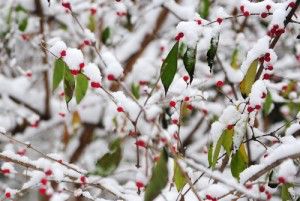The Garden in Snow
The Garden in Snow
By Deborah Clark
NABBW’s Gardening Expert
 Looking out at my yard covered with a 10-inch thick snow blanket, it’s hard to imagine it popping with green life. The winter palette is subtle and today it’s predominantly white, with various branches showing their earth tones – grays, ochers, siennas, umbers.
Looking out at my yard covered with a 10-inch thick snow blanket, it’s hard to imagine it popping with green life. The winter palette is subtle and today it’s predominantly white, with various branches showing their earth tones – grays, ochers, siennas, umbers.
It’s now that you can appreciate the structure of trees and shrubs, with their various shapes and textures.
- The birch in the neighboring yard shows its frilly branches and exfoliating bark.
- The graceful curves of the oakleaf hydrangeas on this side of the fence look like an artfully arranged Japanese centerpiece, some dead flower heads still clinging.
- The smooth skin of the styrax obassia is perhaps the most beautiful of all, with its limbs that curve like a fan of underwater coral.
Green isn’t absent though. Leaves on conifers and broadleaf evergreens azaleas, nandinas, hollies, aucubas and viburnums are visible from my window. These leaves are different shapes and sizes, as well as different shades of green, including the yellow speckles on the variegated viburnum.
Snow comes in all varieties too: The one this week is heavy, deep and wet. I used a broom to sweep it off branches it had trapped – overpowering the nandinas and azaleas and threatening to break them. Although out of my reach, the conifers visible in neighboring yards desperately needed a good sweep, as their fragile branches are particularly susceptible to breaking under the snow. As I liberate the filigree twigs of the spirea vanhouttei, I marvel at the genius of its engineering when it springs back to position.
 Infrequent color shines out like beacons against the white: red berries on the nandina, holly, and winterberry and orange ones on the cotoneaster pragense seem to beckon the birds. I’ve seen snow on Chrysanthemums in the fall and on crocus, narcissus and galanthus in the spring, none of which it bothers by its temperature, though perhaps by of its weight. Still, I’ve seen the flowers triumph after the snow melts.
Infrequent color shines out like beacons against the white: red berries on the nandina, holly, and winterberry and orange ones on the cotoneaster pragense seem to beckon the birds. I’ve seen snow on Chrysanthemums in the fall and on crocus, narcissus and galanthus in the spring, none of which it bothers by its temperature, though perhaps by of its weight. Still, I’ve seen the flowers triumph after the snow melts.
Snow actually provides winter protection for many plants. Maryland experiences more frosts and thaws throughout the winter than any other place in the United States (unless this statistic has altered because of climate change). The constant heaving and thawing is very wearing on root systems, and often throws bulbs into confusion and sometimes pops them out of the ground entirely. But a blanket of snow acts like a mulch, and keeps the ground underneath at an even temperature. On a day like today that’s above freezing, it also serves to slowly water the plants.
Snow gives the garden a chance to rest, and give gardeners like me a chance to regenerate too, as we move through the seasons.
Deborah Clark says she might never have taken up gardening if she hadn’t had neighbors who shared their love of gardening with her – but moved away.
It all started in 1973, she says, when a departing neighbor invited her to take care of an already-planted community vegetable garden plot: all she had to do was weed and harvest. She was hooked.

